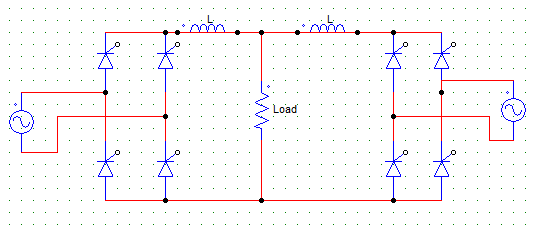This set of Advanced Power Electronics Multiple Choice Questions & Answers (MCQs) focuses on “Dual Converters-3”.
1. Name the circuit shown in the figure below.

a) Single-phase circulating current type dual converter
b) Single-phase non-circulating current type dual converter
c) Three-phase circulating current type dual converter
d) None of the mentioned
View Answer
Explanation: The converters are connected in parallel not in anti-parallel.
2. Dual converters handle ________ during no load.
a) very high temperature
b) no current
c) only circulating current
d) load current
View Answer
Explanation: During no load period, both the converters handle only the circulating current as the load current is zero.
3. In a three phase dual converter, converter 1 is operating with α = 95° and converter 2 is operating with α2 = 85°. Choose the correct statement.
a) Converter 1 is operating as a rectifier and converter 2 as an inverter
b) Both the converters are operating as a rectifier
c) Converter 1 is operating as a inverter and converter 2 as an rectifier
d) Both the converters are operating as an inverter
View Answer
Explanation: As α1 > 90, converter 1 is operating as a inverter and with α2<90, converter 2 is working as an inverter.
4. The circuit shown below is that of a

a) single-phase circulating current type dual converter
b) three-phase non-circulating current type dual converter
c) three-phase circulating current type dual converter
d) none of the mentioned
View Answer
Explanation: It is a 3-phase as it uses 6 SCRs on either sides, it is circulating current type as there is a reactor (L) placed on either sides of the load to compensate for the circulating current.
5. In circulating current type of dual converters, the nature of voltage across the reactor is
a) triangular
b) pulsating
c) constant
d) alternating
View Answer
Explanation: The current is alternating in nature.
6. When a line commutated converter operates in the inverter mode then
a) it draws real and reactive power from the supply
b) it delivers both real and reactive power to the supply
c) it delivers real power to the supply
d) it delivers reactive power to the supply
View Answer
Explanation: A converter is given an AC supply, when it is in the inverter mode, it is sending power (only real power) to the AC supply and absorbing power (only reactive) power from the supply.
7. The reactor is required in a circulating current type dual converter to
a) improve the power factor
b) smooth-en the waveform of circulating current
c) limit the circulating current
d) increase the circulating current
View Answer
Explanation: Reactor (inductance) is introduced in the circulating current mode between both the converters. The reactor limits the current to a reasonable value.
8. In the below given figure the converter 1 (to the right side) has firing angle = α1, converter 2 has firing angle = α2. For the dual converter to operate in the second quadrant.

a) α1 > 90°
b) α2 > 90°
c) α1 < 90°
d) α2 < 90°
View Answer
Explanation: Converter 1 would control the first and the fourth quadrant and converter 2 would operate in the second and the third quadrant. In the second quadrant, voltage should be positive and current should be negative, hence inverter operation hence α2 > 90°.
9. If V1 and V2 are the converter output voltages then the reactor voltage is
a) V1 + V2
b) V1 – V2
c) V1 x V2
d) none of the mentioned
View Answer
Explanation: The reactor voltage Vr is the difference of the converter output voltages.
10. In the below given figure, the converter 1 (to the right side) has firing angle = α1, converter 2 has firing angle = α2. For the dual converter to operate in the fourth quadrant.

a) α1 > 90°
b) α2 > 90°
c) α1 < 90°
d) α2 < 90°
View Answer
Explanation: Converter 1 would control the first and the forth quadrant and converter 2 would operate in the second and the third quadrant. In the fourth quadrant, voltage should be negative and current should be positive, hence C1 as an inverter is operated with α1 > 90°.
Sanfoundry Global Education & Learning Series – Power Electronics.
To practice advanced questions on all areas of Power Electronics, here is complete set of 1000+ Multiple Choice Questions and Answers.
If you find a mistake in question / option / answer, kindly take a screenshot and email to [email protected]
